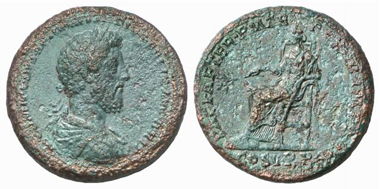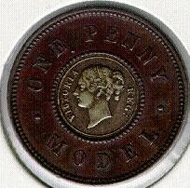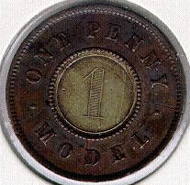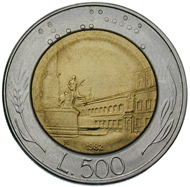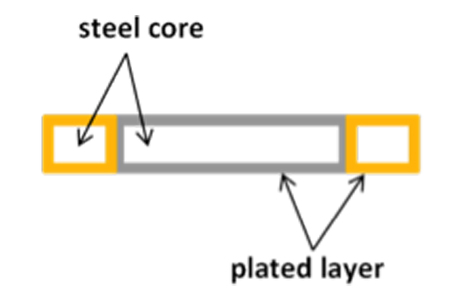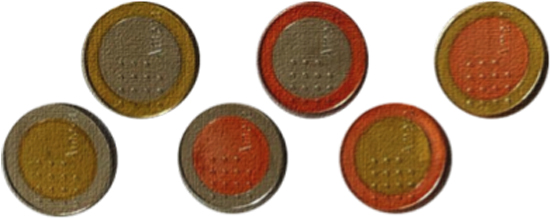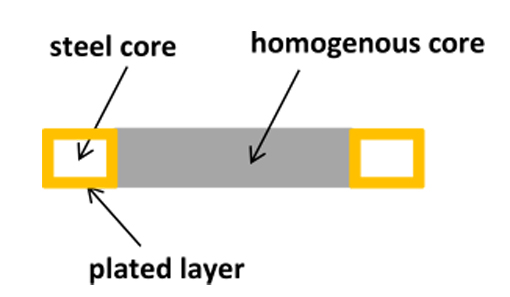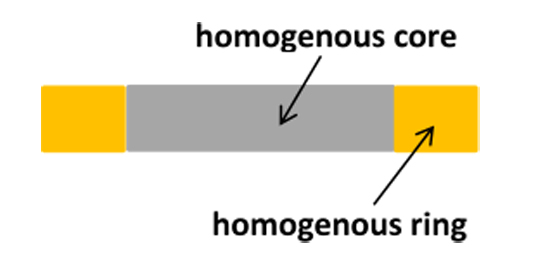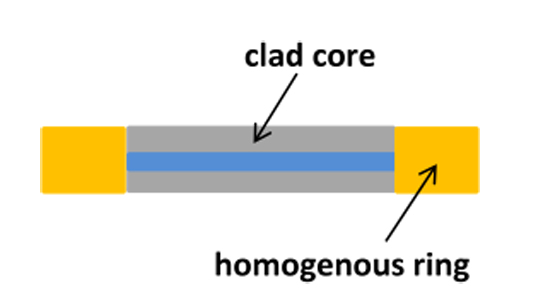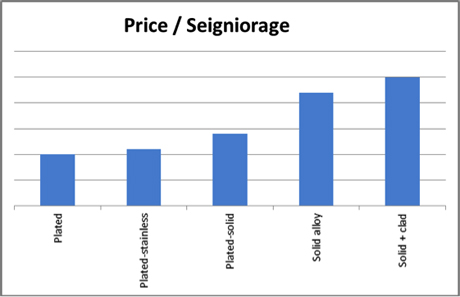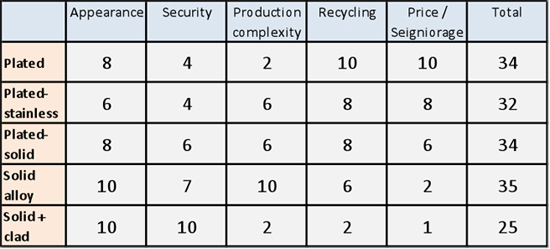by Dimitrina Fileva
April 9, 2013 – Bicolor coins are very well accepted by the users. So, which possibilities do exist to produce inexpensive bicolor coins. Dimitrina Fileva compares the different options.
Introduction
Most of all people, if asked, would take out of their pockets or purses a few bicolor coins. Almost instinctively one reaches for such a coin when buying something. Conducting a survey among the public the perception of the bicolor coins can be quickly summarized as follows: The bicolour coins are well liked; they are considered as attractive, more valuable, long lasting and more can be bought with them.
Naturally comes the question: Why are bicolour coins then not used more? Is it because they are also perceived as being expensive and complicated to produce?
The production and introduction of the modern circulation bicolor coins started just 30 years ago although examples of such coins date centuries back. There is already introduced, however not yet widely spread, a cheaper alternative for the production of bicolour coins using electroplating technology. Employing electroplating technology to produce completely or part of the coin reduces significantly the material costs.
Here is a review of the existing different options in terms of material selection, which could be considered when a new bicolor circulation coin would be designed.
Roman bimetal medallion made of brace and copper. Struck in 189. Photo: Künker.
How it all began
The first to produce coins from two different medals were the Romans. They used this technology for their most representative issues: Imperial commemorative medallions.
English coins having a copper square plug in tin base. Photo: Bi-Metallic Collectors Club.
The first modern bicolor coins were introduced in circulation in the 17th century following the need to reduce costs but still not allowing easy counterfeit. The first examples differ quite a lot from what we are used to have as a bicolor coin nowadays.
Joseph Moore’s “model” penny made in 1844 in England. Photo: Bi-Metallic Collectors Club / Frans Woons.
Later in England as a proposal to replace the relatively large existing coins, Joseph Moore produced the “model” pennies and half-pence. Though not legal tender, Moore’s tokens were circulated widely and accepted at face value by many merchants.
500 Lira, Italy, 1982. Photo: MoneyMuseum.
In 1982 in Italy the 500 Lira coin was introduced into circulation and this coin already has the appearance of the widely spread bicolor coins. After Italy other countries like Morocco, France, Monaco, Thailand, etc. issued their bicolor coins.
Today more than 115 countries have issued at least one circulation bicolor coin and the number is growing.
Manufacturing process for bicolor coins
The manufacturing process includes the following steps:
- Blanking of discs for rings and cores
- Rimming, for rings (as discs) also edge-lettering
- Piercing of the discs for the rings
- Electroplating, when the coin is completely or partially plated
- Assembly of both parts
- Minting
Schematically it can be presented like:
Usually the production process takes place at more than one location and there are some specialties characterizing each step, like:
- Supply of the exact raw material – the requirements towards the raw material are really high and there are not many suppliers worldwide able to meet them all
- Possession and use of special equipment for the mechanical processing – blanking, rimming and edge lettering
- Taking care of the scrap after blanking and piercing – especially when talking about copper alloys
- Possession of plating equipment for big volumes and applying special technologies
- Possession and use of special equipment for assembly and minting
All these specialties, technologies and know-how reduce the risk for a large scale counterfeit.
Material variations
There are different ways material- and productionwise to manufacture a bicolor coin which has for instance white/silver core and yellow/gold ring. Here follows a review of the alternatives in respect of the used materials and few words about the advantages and disadvantages of each of them:
1. Electroplated bicolor coins
Both inner core and outer ring are made from electroplated low carbon steel. Here apart from the typical white color coming from nickel plating, yellow color coming from brass plating also a red color can be added with copper plating, giving more color combinations.
The biggest advantage of the electroplated bicolor coins is undisputedly their low price and therefore their high seigniorage. They can be recycled directly as a whole after decoining and material losses due to recycling will be the smallest.
Their disadvantage is related with the usage in vending machines as security by EMS validation can be achieved with special adjustments of the validators or by special plating.
2. Mixed bicolor coins
Outer ring is made from electroplated low carbon steel and the inner core is made from a homogenous metal – copper alloy, stainless steel or aluminum. Actually the reverse combination – plated core with a homogeneous ring is also possible but not really typical.
Their advantage is the still low price and by using a copper alloy core the security by EMS validation can be enhanced. Here the combination between the metals used is very important as potential big difference of the material properties between the ring and the core can influence the minting quality or the wear.
It is considered as disadvantage that by recycling the coins must be first separated in order to obtain maximum recovery of the metal costs.
3. Bicolor coins from homogeneous alloys
Both inner core and outer ring are made out of homogenous alloys. Most commonly used are copper based alloys, in white/silver and yellow/gold colors, as their electrical conductivity varies in narrow range and can be easily reproduced and verified.
For this variant there is a change of the balance price-EMS validation, the price gets steeply upwards and there is an improved security during the EMS validation though depending strongly on the material/alloy selection. It is also a must to separate the coins before recycling.
4. Mixed bicolor coins from homogeneous alloy ring and clad core
The outer ring is made from homogenous alloy and the inner core from clad metal – the 1 and 2 euro coins are typical representatives of this group. By using clad material there is also a possibility to use differently colored outer cover metal so that the final coin will have three colors – the so called flip-flop coins. The high price and difficulties by recycling however make this option not desirable for circulation coins.
By carefully selected material combination, this version offers the highest security by EMS validation. Apart from the high price there are some other disadvantages which have to be considered like: very restricted number of suppliers for the clad material, recyclability and metal value are severely impacted by the metal choice for the clad core and the separation before recycling is a must.
Comparison and ranking
After the review of the different material alternatives now follows a direct comparison and ranking in the characteristics:
- Price/seigniorage
- Appearance – quality of the image/relief, mintability
- Security – only the EMS validation will be considered as all the groups can bear the same external security features
- Production complexity – in terms of production steps, used technologies, availability of raw materials
- Recycling – taking into consideration the need of previous separation, recovery of metal costs, further usage of the recycled material
- Overall ranking
Here is a comparison only in terms of price/seigniorage:
The group of coins made out of plated and homogeneous metal parts is further separated in two depending on the type of the used metal, as the difference in price between stainless steel or aluminum and copper alloy is significant.
It can be seen that the price for the last version – solid alloy core and inner core made of clad metal is approximately 2,5 times higher than the one of the entirely electroplated coins. This gap can increase even more when the losses due to recycling are considered.
The complete ranking can be seen in the table below:
Legend: 10 best score; 1 worst score.
From the results it can be seen that the completely or partially electroplated coins with copper alloy core take two of the top 3 positions as bicolor options.
Conclusion
There are different possibilities for a bicolor to be produced and such a coin is not necessarily prohibitively expensive.
According to the specifics of each country – circulation coins sets, coins value, degree of usage of vending machines, etc., a bicolor coin can be chosen that will provide positive seigniorage with a sufficient security.
A good example for well-balanced bicolor coins is the plated one and the mixed plated with a copper alloy inner part.
There is a good opportunity to introduce more and more bicolor coins into circulation in the countries with just one or without any of them and these are more than 2/3 of all the countries in the world.





